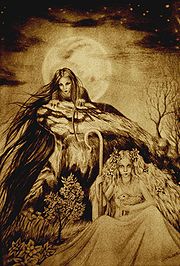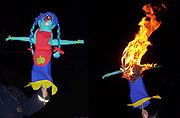
Marzanna
Encyclopedia

Maržanna, Mara, Maržena, Morana, Moréna, Mora, Marmora or Morena is a Slavic goddess associated with death, winter and nightmares. Some sources equate her with the Latvia
Latvia
Latvia , officially the Republic of Latvia , is a country in the Baltic region of Northern Europe. It is bordered to the north by Estonia , to the south by Lithuania , to the east by the Russian Federation , to the southeast by Belarus and shares maritime borders to the west with Sweden...
n goddess Māra, who takes a person's body after their death. Some medieval Christian sources such as the Mater Verborum also compare her to the Greek
Greek mythology
Greek mythology is the body of myths and legends belonging to the ancient Greeks, concerning their gods and heroes, the nature of the world, and the origins and significance of their own cult and ritual practices. They were a part of religion in ancient Greece...
goddess Hecate
Hecate
Hecate or Hekate is a chthonic Greco-Roman goddess associated with magic, witchcraft, necromancy, and crossroads.She is attested in poetry as early as Hesiod's Theogony...
, associating her with sorcery. The Polish chronicler Jan Długosz (15th cent.) likened her to Ceres
CERES
CERES may refer to:* California Environmental Resources Evaluation System * Centre for European, Russian, and Eurasian Studies of the University of Toronto...
, the Roman goddess of agriculture.
Central Europe

Equinox
An equinox occurs twice a year, when the tilt of the Earth's axis is inclined neither away from nor towards the Sun, the center of the Sun being in the same plane as the Earth's equator...
, the rite involves setting fire to a female straw effigy, drowning it in a river, or both. In Poland, this is often performed during a field trip by children in kindergartens and primary schools. The effigy can range in size from a puppet to a life-size dummy. This ritual represents the end of the dark days of winter, the victory over death, and the welcoming of the spring rebirth.
Russia
In the Book of Veles, Marzanna is a sorceress and enchantress who turns the sun god DažbogDazbog
Dažbog , alternatively Dazhbog, Dazbog, Dazhdbog, or Dadzbóg, was one of the major gods of Slavic mythology, most likely a solar deity and possibly a cultural hero...
into an ox. She refuses to turn him back until his father, Perun
Perun
In Slavic mythology, Perun is the highest god of the pantheon and the god of thunder and lightning. His other attributes were the fire, mountains, the oak, iris, eagle, firmament , horses and carts, weapons and war...
, allows them to marry. However, she later leaves him for Koschei
Koschei
In Slavic folklore, Koschei is an archetypal male antagonist, described mainly as abducting the hero's wife. None of the existing tales actually describes his appearance, though in book illustrations, cartoons and cinema he has been most frequently represented as a very old and ugly-looking man...
, son of the Underworld lord Vij, and as Dažbog searches for his wife the couple conspire to kill him. Marzanna drugs him and Koschei throws him down a well. Finally, she nails him to a mountain in the Caucasus. However, the goddess Zhiva rescues Dazhbog and he returns to get his revenge. This story is somewhat reminiscent of the Welsh tale of Blodeuwedd
Blodeuwedd
Blodeuwedd or Blodeuedd, , is the wife of Lleu Llaw Gyffes in Welsh mythology, made from the flowers of broom, meadowsweet and the oak by the magicians Math and Gwydion, and is a central figure in the fourth branch of the Mabinogi.-Role in Welsh tradition:The...
, who betrays her husband for the love of another man and, with her lover, conspires to kill him.
Marzanna's rites survived into Christian times as Maslenitsa
Maslenitsa
Maslenitsa . Maslenitsa corresponds to the Western Christian Carnival, except that Orthodox Lent begins on a Monday instead of a Wednesday. The Orthodox date of Easter can differ greatly from the Western Christian date. In 2008, for example, Maslenitsa was celebrated from March 2 to March...
, a six- or seven-day feast celebrated in early March. During the first five or six days of Maslenitsa, flat blini
Blintz
A blin, blintze, or blintz is a thin pancake. It is somewhat similar to a crêpe with the main difference being that yeast may be used in blini, but not in crêpes.-Etymology, origins, culture :...
were served, believed to symbolize the Sun.
Interpretation
Some interpretations of this ritual argue that setting fire to a female straw puppet in the last day of winter symbolises the triumph of the "patriarchal", Christian religion over the pagan, "matriarchal" order. The burning and drowning may bring associations with the punishment for witches in the Middle Ages. However, the Marzanna rite is of pre-Christian, pagan origin, preceding witch trials by several centuries.Sources
- Marjorie Yovino-Young. Pagan Ritual and Myth in Russian Magic Tales: A Study of Patterns. Edwin Mellen Press, 1993
- D.A. Gavrilov, A.E. Nagovitzhyn. Slavic Gods. Paganism. Tradition (Боги славян. Язычество. Традиция.) Moscow, 2002
- Skvortzov, Konstantin. Mater Verborum, XIIIth century Czech manuscript, with comments. Saint Petersburg Academy of Sciences, 1853.

